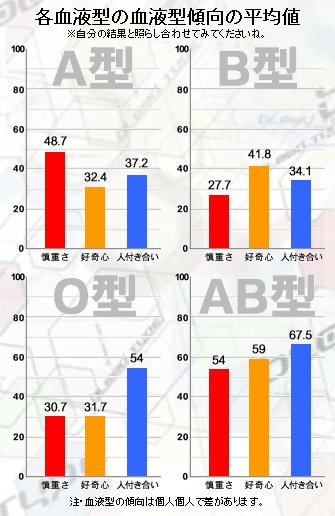
Prof. Ohmura
ABO FAN
 Professor Ohmura
and Cloninger's Personality Dimensions
Professor Ohmura
and Cloninger's Personality Dimensions
Professor Ohmura who is famous honorary
professor of Nihon University, once said the he got consistent results using
Cloninger's Personality Dimensions. Though the results was televised twice
in 2004, no articles shown -- till now. Why?
 Introduction
Introduction
Have you heard about Cloninger's personality
dimensions? I am ashamed to say that I did not know until now. (^^;;
However, without knowing it, I explained this topic....
Excerpts from hypothesis are below.
According to the authors, certain genes affect dopamine or serotonin to make difference of
personality traits.
Some researchers say that certain HLA
types might affect neuronal post-synaptic membrane sensitivity to central
neurotransmitters -- such as dopamine -- because both chemical structure is much the same.
So, ABO blood type might affect dopamine and/or serotonin to make difference of
personality traits if structure is much the same ...
Then what kind of personality test would get
such a result? In fact, it is Cloninger's personality dimensions!!
Excerpts from hypothesis:
 About Cloninger's
Personality Dimensions About Cloninger's
Personality Dimensions
The Gene
and Personality
Dean Hamer, Ph. D., is Chief of Gene Structure and
Regulation at the National Cancer Institute's Laboratory of Biochemistry. Coauthor
Peter Copeland is an award winning journalist.
According to the authors, certain genes affect dopamine or serotonin to make difference of
personality traits.
Some researchers say that certain HLA
types might affect neuronal post-synaptic membrane sensitivity to central
neurotransmitters -- such as dopamine -- because both chemical structure is much the same.
So, ABO blood type might affect dopamine and/or serotonin to make difference of
personality traits if structure is much the same ...
Living with Our Genes -- Why They Matter More Than You
Think --(1998) by Dean Hamer, et. al. (from pp. 76-80)

Murphy and Lesch's persistence
had paid off. They'd found an inherited variation in DNA that clearly affected serotonin
transport. Here was a little button effectively controlling levels of serotonin in the
brain. Now the key question was, What did this "genetic Prozac" do in human
beings? What effect did it have on temperament?
[abbreviated]
The final analysis was to look at Cloninger's predictions. He had
theorized that serotonin would be involved in harm avoidance, and now we had a chance to
test the theory. He was right. We found a significant correlation between this DNA region
and the trait he called harm avoidance, which we could estimate by mathematically
rearranging the questions from the five-factor test. There was no correlation for any of
the other traits he identified. This was the second confirmation of Cloninger's theory. He
also had guessed right that dopamine was linked to novelty seeking, and now he was proved
right that serotonin was linked to harm avoidance. His model of personality was starting
to look pretty good indeed.
There was one intriguing twist to the story. The people with the
highest level of anxiety-related traits had the short version of the gene promoter. This
meant that where the serotonin transporter was least efficient, people had the most
anxiety. This was the opposite of the Eli Lilly explanation for how serotonin works; it
should have been the lowered serotonin transporter levels that were associated with
decreased harm avoidance. Our results were more consistent with the "classical"
model that serotonin causes rather than alleviates anxiety, depression, and other elements
of harm avoidance.
It's difficult to draw any firm conclusion yet about the
direction of serotonin action, however, because it's possible that a lifelong decrease in
serotonin transporter gene expression actually decreases serotonin signaling through a
feed back or compensatory mechanism. What's really needed is a direct way to measure
serotonin signaling in the living brain -- but that's not available yet.
Our study not only confirmed the connection between the
serotonin transporter and harm avoidance, but it also provided the first conclusive
evidence that the multiple facets harm avoidance are connected at the level of the genes.
That's because the differences in the DNA correlated equally well with several different
aspects of harm avoidance: anxiety, depression, hostility, pessimism, and fatigability.
Thus the results were a satisfying confirmation of the claim that a single set of genes --
in this case just one gene -- can influence distinct traits that are obvious in real
people.
REFERENCE:
Lesch, Klaus-Peter, Dietmar Bengel, Armin Heils, Sue Z. Sabol, Bejamin D. Greenberg,
Susanne Petri, Jonathan Benjamin, Clemens R. Muller, Dean H. Hamer, and Dennis L. Murphy.
"Association of Anxiety Related Traits with a Polymorphism in the Serotonin
Transporter Gene Regulatory Region Science 274,1527-31 1996.
REFERENCE:
Lesch, Klaus-Peter, Dietmar Bengel, Armin Heils, Sue Z. Sabol, Bejamin D. Greenberg,
Susanne Petri, Jonathan Benjamin, Clemens R. Muller, Dean H. Hamer, and Dennis L. Murphy.
"Association of Anxiety Related Traits with a Polymorphism in the Serotonin
Transporter Gene Regulatory Region Science 274,1527-31 1996.
Underlined sentences are authors'
conclusions. After all, dopamin is connected to novelty-seeking and seretonin
connected to harm avoidance. Might Type B affect dopamine and Type A affect seretonin?
That can explain the difference of personality by blood type ...
|
 Mr. Ohumra on TV Programs
(No.1)
Mr. Ohumra on TV Programs
(No.1)
Mr. Ohmura is an honorary professor of Nihon
University (psychology). He write many articles about "relationship
between blood type and personality" -- though mostly negative or ambiguous
results.
Now, he have got consistent results using
Cloninger's Personality Dimensions.
He appeared in TV programs "SPA SPA Humanics"
(TBS; Tokyo Broadcasting System) which was televised on October 7, 2004.
Psychological test that was used in the program is... Cloniger's personality
dimensions.
The following is the results using 112
subjects:
1. Harm Avoidance: A > O > AB > B
The ratio of type A was harm avoidance 60%, reward
dependence 30%, novelty seeking 10%.
2. Novelty Seeking B > O > AB > B
The ratio of type B was novelty seeking 70%, reward
dependence 20%, harm avoidance 10%.
3. Reward Dependence O > A > B >AB
The ratio of type O was reward dependence 60%, harm
avoidance 15%, novelty seeking 20%.
Somehow, type AB was not definite
# Need not to say that the results almost in
accordance with indication of Mr. Nomi.
According Cloninger's Personality Dimensions,
serotonin has relation to a tendency to novelty seeking (type B), dopamine
and a tendency to reward dependence (type O), norepinephrine and a tendency to
harm avoidance (type A), each.
 Mr. Ohumra on TV Programs
(No.2)
Mr. Ohumra on TV Programs
(No.2)
Afterwards, Mr. Ohmura checks reappearance on
TV program of other station (TV Asahi; Asahi National Broadcasting). The
number of subjects are 746 (ages 18 - 87, sexes are not know)
"An ABOAB blood type personality diagnosis" on
December 28, 2004
Intellectual entertainment to introduce the mystery of blood type from
scientific standpoints.
Mr. Ohmura said that differences
appeared definitely by using Cloninger's Prototype, too. In other
words, there is reappearance.
Average of Tendencies by Blood Type
| |
A |
B |
O |
AB |
| Harm Avoidance (Red) |
48.7 |
27.7 |
30.7 |
54 |
| Novelty Seeking (Orange) |
32.4 |
41.8 |
31.7 |
59 |
| Reward dependence (Blue) |
37.2 |
34.1 |
54 |
67.5 |
Data From TV Program's Website

Though the results was televised twice in
2004, no articles shown -- till now. Why?
(March 18, 2007)
 English Home Page
English Home Page
Last update: March 18, 2007.

